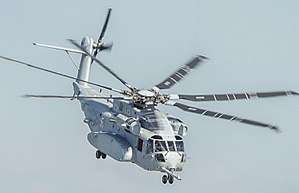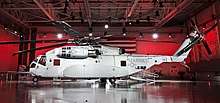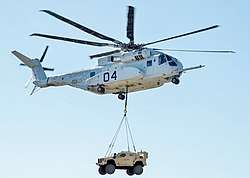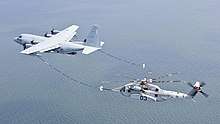Sikorsky CH-53K King Stallion
The Sikorsky CH-53K King Stallion is a heavy-lift cargo helicopter currently being developed by Sikorsky Aircraft for the United States Marine Corps (USMC). The design features three 7,500 shp (5,590 kW) engines, new composite rotor blades, and a wider aircraft cabin than previous CH-53 variants. It will be the largest and heaviest helicopter in the U.S. military. The USMC plans to receive 200 helicopters at a total cost of $25 billion. Ground Test Vehicle (GTV) testing started in April 2014; flight testing began with the maiden flight on 27 October 2015. In May 2018, the first CH-53K was delivered to the Marine Corps.
| CH-53K King Stallion | |
|---|---|
 | |
| A CH-53K during a test flight in West Palm Beach | |
| Role | Heavy-lift cargo helicopter |
| National origin | United States |
| Manufacturer | Sikorsky Aircraft |
| First flight | 27 October 2015 |
| Status | In production |
| Primary user | United States Marine Corps |
| Program cost | US$25.335 billion (FY2015)[1] |
| Unit cost | |
| Developed from | Sikorsky CH-53E Super Stallion |
Development
H-53 background
The CH-53 was the product of the US Marine Corps' "Heavy Helicopter Experimental" (HH(X)) competition begun in 1962. Sikorsky's S-65 was selected over Boeing Vertol's modified CH-47 Chinook version. The prototype YCH-53A first flew on 14 October 1964.[4] The helicopter was designated "CH-53A Sea Stallion" and delivery of production helicopters began in 1966.[5] The CH-53A was equipped with two T64-GE-6 turboshaft engines, and had a maximum gross weight of 46,000 lb (20,865 kg).
Variants of the original CH-53A Sea Stallion include the RH-53A/D, HH-53B/C, CH-53D, CH-53G, and MH-53H/J/M. The RH-53A and RH-53D were used by the United States Navy for minesweeping. The CH-53D included a more powerful version of the General Electric T64 engine, used in all H-53 variants, and external fuel tanks.[4] The US Air Force's HH-53B/C "Super Jolly Green Giant" were for special operations and combat rescue. The Air Force's MH-53H/J/M Pave Low helicopters were the last of the twin-engined H-53s, and were equipped with extensive avionics upgrades for all-weather operation.[4]
In October 1967, the U.S. Marine Corps issued a requirement for a helicopter with a lifting capacity 1.8 times that of the CH-53D, that could fit on amphibious assault ships. Before this, Sikorsky had been working on an enhancement to the CH-53D, under the company designation "S-80", featuring a third turboshaft engine and a more powerful rotor system. Sikorsky proposed the S-80 design to the Marines in 1968. The Marines considered this a good, quick solution, and funded development of a testbed helicopter.[6] Changes on the CH-53E also included a stronger transmission and a fuselage stretched 6 feet 2 inches (1.88 m). The main rotor blades' material was changed to a titanium-fiberglass composite.[6] A new automatic flight control system was added. The vertical tail was also enlarged, with the tail rotor tilted upwards slightly to provide some lift in hover.[7]
The initial YCH-53E first flew in 1974.[7] Following successful testing, the initial production contract was awarded in 1978, and service introduction followed in February 1981.[6] The US Navy acquired the CH-53E in small numbers for shipboard resupply. The Marines and Navy acquired a total of 177.[6] For the airborne mine countermeasures role, the Navy later ordered a CH-53E version designated "MH-53E Sea Dragon" with enlarged sponsons and fuel tanks for greater fuel storage.[6] The Navy began using the MH-53E in 1986.[7] The Navy obtained 46 Sea Dragons.[6]
CH-53K

The USMC had planned to upgrade most CH-53Es to keep them in service, but this plan stalled. Sikorsky proposed a new version, originally designated "CH-53X"; in April 2006, the USMC signed a contract for 156 aircraft as the "CH-53K"[8][9][10] valued at $18.8 billion with deliveries to be completed by 2021.[11] The USMC planned to start retiring CH-53Es in 2009, thus needing replacements quickly as some rotorcraft reached their structural life limits in 2011–12.[11] Flight testing of the CH-53K was expected to begin in 2011.[12]
The CH-53K is a general redesign of the CH-53E. The main improvements are new engines and cockpit layout. The CH-53K will have over twice the lift capacity and radius of action of the CH-53E, and a wider cargo hold to allow it to carry a Humvee internally. The CH-53K will feature new stubby composite sponsons to cut overall width, resulting in a narrower footprint for shipboard operations.[12] It will also be equipped with a new composite rotor blade system, with technology similar to that found on the UH-60 Black Hawk helicopter. The CH-53K will use the General Electric GE38-1B engine,[13] selected over the Pratt and Whitney Canada PW150 and a variant of the Rolls-Royce AE 1107C-Liberty used on the V-22 Osprey.[14]
In August 2007, the USMC increased its order of CH-53Ks from 156 to 227.[15] In 2007, first flight was planned for November 2011 with initial operating capability (IOC) by 2015.[16] When the CH-53K enters service, it will serve as the USMC's heavy lift helicopter with the MV-22 (medium lift) and UH-1Y (light lift).[17] RAND released a report in 2007 on seabasing that suggested a higher ratio of CH-53Ks to MV-22s would reduce deployment times from naval ships.[18][19]
In 2008, design work was well underway, while weight reduction efforts to meet operational requirements were progressing. Increases in engine performance and rotor blade improvements are options to help meet requirements if needed. The rotor mast tilt was decreased and components shifted to ensure the center of gravity does not shift too far rearward as fuel is burned.[20] The design requirements were 'frozen' in 2009–10 and not changed since.[21]
On 22 January 2010, Sikorsky opened a $20 million Precision Components Technology Center in Stratford, Connecticut, which shall produce CH-53K elements, such as the rotating and stationary swashplates, main and tail rotor hubs, and main rotor sleeves.[22] On 3 August 2010, the CH-53K passed its Critical Design Review (CDR), becoming ready for test production.[23][24] However, the IOC fielding date was deferred to 2018.[25] Sikorsky proposed building four pre-production aircraft for evaluation.[26]
.jpg)
On 4 December 2012, Sikorsky delivered the first CH-53K, a Ground Test Vehicle (GTV) airframe. Preliminary tests included calibrating the aircraft's fuel system and attaching measuring devices at various test locations on the airframe to record temperature, aerodynamic loads, pressure, and vibrations. Two additional static ground test articles underwent structural testing at the firm's main manufacturing plant in Stratford, Connecticut.[27]
In January 2013, the program was estimated to cost US$23.17 billion after procurement of the planned 200 CH-53Ks.[1] In April 2013, the U.S. Navy program manager stated that development was "proceeding so well" that it might become operational ahead of schedule.[28] Flight testing was planned for 2015, being delayed by over a year by faulty components.[1]
On 31 May 2013, the Navy awarded Sikorsky a $435 million contract to deliver four prototype CH-53Ks for operational evaluation and mission testing;[29] Sikorsky says the first two prototypes will examine structural flight loads while the third and fourth vehicles will focus on validating general performance, propulsion and avionics.[30]
On 1 October 2013, Sikorsky issued an $8.5 million contract to Kratos Defense & Security Solutions for the design and development of maintenance training systems for the CH-53K, including a full-fidelity Maintenance Training Device Suite (MTDS) and a Helicopter Emulation Maintenance Trainer (HEMT). The MTDS provides a realistic environment for training and evaluating maintainers of the CH-53K's various subsystems, such as avionics, electrical, and hydraulic systems. The HEMT uses a 3D virtual environment to support maintenance training scenarios, including functional tests, fault isolation, troubleshooting, and remove and installation for 27 subsystems.[31]
On 24 January 2014, the CH-53K GTV ignited its engines, spinning the rotor head without rotors attached. Low-rate production is planned to proceed from 2015 to 2017. Initial operating capability (IOC) was set to occur in 2019, with full-rate production commencing between then and 2022. The USMC intends to have eight active CH-53K squadrons, one training squadron, and one reserve squadron.[32] In April 2014, testing with blades attached began, system integration followed. Flight testing was set to start in late 2014, each test aircraft flying approximately 500 hours over three years.[33] The maiden flight was delayed,[34][35] due to issues with the titanium quill shafts[36] in the transmission and gear box.[37]
On 5 May 2014, General James F. Amos announced during the CH-53K's official rollout that it will be called the "King Stallion".[38] On 27 October 2015, the CH-53K took its first flight.[39] On 7 March 2018, one lifted a payload of 36,000 pounds (16,330 kg), the maximum weight on the single center point cargo hook.[40][41] The first CH-53K was delivered to the USMC on 16 May 2018; at the time, 18 additional helicopters were in production, and the second was planned for delivery in early 2019.[42]
In December 2018, the CH-53K was projected to not be ready for combat as expected in late 2019, due to delivery delays caused by technical flaws found in testing, which resulted in a major program restructuring. Flaws included the engine re-ingesting exhaust gas, limited service life for the rotor gear boxes, late deliveries of redesigned parts, and deficiencies with the tail rotor and driveshaft.[43] It is estimated that the delay will push back delivery of combat-ready CH-53Ks until May 2020.[44]
The US Marine Corps received its first CH-53K simulator at Marine Corps Air Station New River in Jacksonville, North Carolina on 1 May 2020. It is a Containerized Flight Training Device (CFTD) built by Lockheed Martin, Sikorsky's parent company.[45]
Design

The CH-53K is a general redesign with new engines and cockpit layout.[12] The CH-53K will use General Electric T408 (GE38-1B) engines rated at 7,500 shp (5,600 kW) each[46] and will be able to fly 20 knots (37 km/h; 23 mph) faster than its CH-53E predecessor.[47]
It will feature a new digital glass cockpit with fly-by-wire controls and haptic feedback, HUMS,[48] a new elastomeric hub system, and composite rotor blades to improve "hot and high" performance.[12][49] The split torque gearbox with quill shafts started development around 2007.[50][51][52] The gearbox assembly including rotor hub and rotating control system weighs around 11,650 lb (5,280 kg),[53] which is heavier than an empty Black Hawk helicopter.[54] The split torque gearbox weighs 5,270 lb (2,390 kg).[51] By comparison, the twin-engine Mil Mi-26 split torque gearbox weighs 8,020 lb (3,639 kg).[55]
The CH-53K will also include an improved external cargo handling system, survivability enhancements, and improvements to extend service life.[12] The cabin will be 30 ft (9.14 m) long by 9 ft (2.74 m) wide by 6.5 ft (1.98 m) tall.[56] Its cabin will be 1 ft (30 cm) wider and 15% larger, but will have new shorter composite sponsons.[12][49]
The CH-53K is to surpass the capability of the CH-53E by carrying nearly double the external payload of 27,000 lb (12,200 kg) over the same radius of 110 nmi (204 km).[47] The CH-53K's payload reaches a maximum of 35,000 lb (15,900 kg).[47] The CH-53K's maximum gross weight will be 88,000 lb (39,900 kg),[54] which is increased over the CH-53E's 73,500 lb (33,300 kg). The CH-53K will keep approximately the same footprint as the CH-53E.[57]
The CH-53K can carry two 463L master pallets, eliminating the need to break apart pallets between airlifter and helicopter.[58][59]
Major subcontractors include Aurora Flight Sciences (main rotor pylon),[57] Exelis Aerostructures (tail rotor pylon and sponsons),[57] GKN Aerospace (aft transition),[57] Onboard Systems International (external cargo hook system),[60] Rockwell Collins (avionics management system),[61] Sanmina-SCI Corporation (Intercommunications System), and Spirit AeroSystems (cockpit and cabin).[57]
Operational history
Germany
In February 2018, Sikorsky signed an agreement valued at around 4 billion euro with Rheinmetall to team up for the German Air Force's CH-53G heavy lift helicopter replacement program, in which the CH-53K is competing against the CH-47F Chinook offered by Boeing. The German Federal Ministry of Defence was expected to issue an official request for information in the second half of 2018, with a timeline to award a contract in 2020 and deliveries to begin in 2023 for an expected order of around 40 helicopters.[62][63][64]
Israel
In 2009, the Israeli Air Force (IAF) said it would evaluate the new variant after it flies.[65] In August 2015, it formalized a requirement for the CH-53K, listing the type as a "very high priority" item to enable the service to perform missions only the platform is capable of. Israel's current CH-53 "Yasur" fleet is to remain operational until 2025.[66]
The CH-53K is competing with the Boeing CH-47F Chinook for an order of approximately 20 helicopters to replace the IAF's current CH-53 Yasur fleet.[67][62][63]
Specifications (CH-53K)
Data from Sikorsky CH-53K,[69] GE38-1B data,[46] and Flightglobal.com[70]
General characteristics
- Crew: 4
- Capacity: 30 passengers or troops / 24x casualty litters 35,000 lb (15,876 kg) payload
- Centre external load hook rating - 36,000 lb (16,329 kg)
- Fore and aft external load hooks rating - 25,200 lb (11,431 kg)
- Internal cargo system:
- Floor loading 300 lb/sq ft (1,464.73 kg/m2)
- Standard 6x 2,500 lb (1,134 kg) USMC 40 in × 48 in (1,016 mm × 1,219 mm) wooden pallets
- Full 463L Pallets 2x 10,000 lb (4,536 kg)
- Half 463L Pallets 5x 5,000 lb (2,268 kg)
- Tactical Bulk Fuel Delivery System 3 x 800 US gal (666 imp gal; 3,028 l) tanks
- Length: 99 ft (30 m) rotor and tail un-folded
- 73 ft 1.5 in (22.29 m) fuselage
- 83 ft 9 in (25.53 m) fuselage with refuel probe retracted
- 94 ft 11.5 in (28.94 m) fuselage with refuel probe extended
- Width: 17 ft 6 in (5.33 m) fuselage
- Height: 28 ft 4.9 in (8.659 m) rotor and tail un-folded
- Cabin Length: 30 ft (9.1 m)
- Cabin Width: 8 ft 7.2 in (2.6 m)
- Cabin Height: 6 ft 6 in (2.0 m)
- Max takeoff weight: 88,000 lb (39,916 kg) with external load
- 74,000 lb (33,566 kg) with maximum internal load
- Fuel capacity:
- 2,286 US gal (1,903 imp gal; 8,650 l) internal in two cells per sponson (15,545 lb (7,051 kg))
- 2,400 US gal (2,000 imp gal; 9,100 l) auxiliary internal in three cabin tanks (16,320 lb (7,403 kg))
- Powerplant: 3 × General Electric T408 (GE38-1B) turboshaft engines, 7,500 shp (5,600 kW) each
Performance
- Maximum speed: 158 kn (182 mph, 293 km/h) at max continuous power, at sea level ISA
- Cruise speed: 170 kn (200 mph, 310 km/h)
- Range: 460 nmi (530 mi, 850 km)
- Combat range: 110 nmi (130 mi, 200 km)
- Service ceiling: 16,000 ft (4,900 m) ISA
- 13,200 ft (4,023 m) ISA +24 °C (75 °F)
See also
Related development
Aircraft of comparable role, configuration and era
Related lists
References
- "GAO-15-342SP DEFENSE ACQUISITIONS Assessments of Selected Weapon Programs" (PDF). US Government Accountability Office. March 2015. p. 69.
- http://m.waaytv.com/redstone_alabama/meet-the-ch--k--the-helicopter-that-for/article_5d5a6c9e-1418-11e7-a851-8f8e666a7c5c.html%5B%5D
- Schogol, Jeff (8 August 2017). "Total cost of CH-53K is $131 million per helicopter: Here's the breakdown". Defense News. Retrieved 9 February 2019.
- Sikorsky Giant Helicopters: S-64, S-65, & S-80. Vectorsite.net, 1 May 2006.
- Frawley, Gerard: The International Directory of Military Aircraft, p. 148. Aerospace Publications Pty Ltd, 2002. ISBN 1-875671-55-2.
- S-80 Origins / US Marine & Navy Service / Japanese Service. Vectorsite.net, 1 May 2006.
- CH-53A/D/E Sea Stallion and MH-53E Sea Dragon. US Navy, 15 November 2000.
- "Sikorsky Awarded $3.0B Development Contract For Marine Corps CH-53K Heavy-Lift Helicopter". Sikorsky Aircraft, 5 April 2006.
- "Sikorsky Aircraft Marks Start of CH-53K Development and Demonstration Phase". Sikorsky Aircraft, 17 April 2006.
- "New Heavy Lift Helicopter Starts Development". U.S. Marine Corps, 9 January 2006.
- Whittle, Richard. USMC CH-53E Costs Rise With Op Tempo Rotor & Wing, Aviation Today, January 2007.
- S-80 Upgrades / CH-53K Archived 26 June 2010 at the Wayback Machine. Vectorsite.net, 1 March 2008.
- "Sikorsky Aircraft Selects CH-53K Main Engines". Sikorsky Aircraft, 22 December 2006.
- "CH-53K: The U.S. Marines' HLR Helicopter Program (updated)". Defense Industry Daily. Watershed Publishing LLC. 28 December 2006. Archived from the original on 2 January 2007.
- "Marines Up Order for New Heavy Lifter" Archived 1 July 2012 at Archive.today. "Rotor & Wing", 1 August 2007.
- "US Marines in desperate need of new CH-53K". Flight Daily News, 21 June 2007.
- Fein, Geoff. "Marine Corps Helicopter Programs Stabilizing, Official Says". Defense Daily, 28 May 2008. (Online subscription article).
- "Warfighting and Logistic Support of Joint Forces from the Joint Sea Base". RAND, 2007.
- Bruno, Michael. "Seabasing Study Promotes CH-53K, JHSV Over MV-22" Archived 22 March 2012 at the Wayback Machine. Aviation Week, 16 October 2007.
- Fein, Geoff. "Navy, Sikorsky Overcoming Challenges To CH-53K Design". Defense Daily, 15 May 2008. (Online subscription article).
- Parker, Andrew. "Pause to Reflect on Obstacle-Filled Road". Aviation Today, 28 May 2014.
- "Sikorsky opens $20M production center". hartfordbusiness.com. Retrieved 22 January 2010.
- "CH-53K helicopter program achieves successful Critical Design review". Rotorhub, 3 August 2010. Retrieved: 4 August 2010.
- "CH-53K Helicopter Program Achieves Successful Critical Design Review". Sikorsky Aircraft, 3 August 2010. Retrieved: 16 August 2010.
- "CH-53K Heavy Lift Helicopter Program Conducts Successful Auxiliary Power Unit 'Light-Off'". Sikorsky Aircraft, 25 August 2010.
- "NAVAIR Evaluating New CH-53K proposal From Sikorsky." Fly Away Simulation. 16 April 2012.
- "Sikorsky delivers first CH-53K". Star Defense. Archived from the original on 8 February 2013. Retrieved 10 December 2012.
- "Sikorsky CH-53K may be operational ahead of schedule". Flightglobal.com, 10 April 2013.
- "Sikorsky awarded $435 million contract for four CH-53K test aircraft." Flight International, 31 May 2013.
- "CH-53K project expands to 120kt and two test helicopters." Flight International, 14 March 2016.
- Kratos to build maintenance trainers for CH-53K – Shephardmedia.com, 1 October 2013
- Sikorsky fires up main CH-53K engines – Flightglobal.com, 10 February 2014
- "Sikorsky begins powered ground tests of CH-53K helicopter with rotor blades". Sikorsky press release. 1 May 2014. Archived from the original on 8 May 2014.
- Drwiega, Andrew. "King Stallion Trots Toward Flight Test Program Archived 22 October 2014 at the Wayback Machine" Aviation Today, 2 October 2014.
- Parsons, Dan (3 December 2014). "Sikorsky CH-53K first flight pushed at earliest to March". www.flightglobal.com. Flightglobal.com.
- "Sikorsky tells US ownership change won't affect CH-53K program". 17 June 2015 – via www.reuters.com.
- Malenic, Marina. "Sikorsky redesigns CH-53K main gear box components as E-models are kept in service" Janes, 14 April 2015. Archive
- "Engineering the Future of Vertical Lift | Lockheed Martin". Sikorsky. Retrieved 9 February 2019.
- "Sikorsky's CH-53K helicopter makes first test flight - Marine Corps". 27 October 2015 – via www.reuters.com.
- Flanker41 (7 March 2018). "CH-53K King Stallion Lifts 36,000 Pounds". Military.com.
- "CH-53K marks heavy-lift milestone - Jane's 360". www.janes.com. Retrieved 9 February 2019.
- The Corps just received its first CH-53K King Stallion. Marine Corps Times. 16 May 2018.
- "Lockheed's $31 Billion King Stallion Helicopter Delayed by New Flaws". Bloomberg. 19 December 2018.
- The $31 Billion King Stallion Helicopter Is the Latest Military Program That Won't Be Combat-Ready on Time. Time.com, 19 December 2018.
- https://www.flightglobal.com/helicopters/first-ch-53k-king-stallion-simulator-delivered-to-us-marine-corps/138235.article
- General Electric Model GE38 page. GE Aviation.
- CH-53K brochure. Sikorsky.
- Head, Elan (2017). "Meet the King". pp. 40–49. Retrieved 22 January 2017.
- "Prototype Assembly Looms As First Production Parts Arrive for CH-53K Heavy Lift Helicopter". Sikorsky Aircraft, 6 August 2009.
- "Marine Corps Prepares New CH-53K for First Flight". DefenseTech, 21 October 2014. Accessed: 23 October 2014.
- He, S., Gmirya, Y., Mowka, F., Leigh, L. "Trade Study on Different Design Configurations of the CH-53K Main Gearbox" Archived 18 November 2015 at the Wayback Machine NASA, 2008
- Buzel, Gregory; Gmirya, Yuriy; He, Shulin; Leigh, Leslie. Load Sharing Test of the CH-53K Split Torque Main Gearbox AHS International/Sikorsky, 2009
- Gmirya, Y., Alulis, M., Palcic, P., Leigh, L. "Design and Development of a Modern Transmission: Baseline Configuration of the CH-53K Drive System Archived 18 November 2015 at the Wayback Machine", NASA, 2011.
- Parker, Andrew. "CH-53K King Stallion Inches Closer to Sunrise" Aviation Today, 6 May 2014. Accessed: 7 May 2014.
- Lev I. Chaiko (1990) Review of the Transmissions of the Soviet Helicopters, pp. 2, 3, 9. NASA Glenn Research Center NASA Technical Memorandum 10363.
- CH-53K Helicopter (click on Attributes tab). Sikorsky.
- "Sikorsky Selects CH-53K Fuselage Supplier Team". Sikorsky Aircraft, 9 May 2007.
- "CH-53K Helicopter." Sikorsky
- Vendrasco, Stephanie. "Cargo cabin mockup ready for some heavy lifting." USMC, 20 December 2007.
- "Onboard Systems awarded Sikorsky CH-53K cargo hook program". "Rotorhub.com", 4 March 2008.
- "Sikorsky Aircraft Selects Rockwell Collins to Provide CH-53K Avionics Management System". Sikorsky Aircraft, 29 June 2006.
- Shalal, Andrea (15 November 2017). "Lockheed's CH-53K helicopter to make global debut at Berlin air show: sources". Reuters. Berlin. Archived from the original on 14 December 2017.
- Shalal, Andrea (5 February 2018). "Lockheed, Rheinmetall team up to bid for German helicopter order". Reuters. Berlin. Archived from the original on 7 February 2018.
- Stevenson, Beth (6 February 2018). "Sikorsky teams with Rheinmetall for German heavy lift competition". IHS Jane's 360. London. Archived from the original on 7 February 2018.
- Egozi, Arie. "Israel drops interest in V-22, eyes CH-53K evaluation." Flight International, 12 November 2009.
- Israeli air force looks for lift from CH-53K Flightglobal.com, 10 August 2015.
- Ahronheim, Anna (2 August 2018). "Two Defense Companies Compete to Replace Israel's Heavy-Lift Helicopters". The Jerusalem Post. Archived from the original on 7 February 2018.
- "US Marine Corps takes delivery of first CH-53K". flightglobal.com. Retrieved 18 May 2018.
- "Sikorsky CH-53K The Only Heavy Lift Solution" (PDF). lockheedmartin.com. Retrieved 28 July 2020.
- Jon Hemmerdinger (21 February 2014), Sikorsky CH-53K testing continues on schedule, Flightglobal
External links
| Wikimedia Commons has media related to Sikorsky CH-53K King Stallion. |
- Sikorsky CH-53K page on Sikorsky.com
- Department of the Navy CH-53K acquisition page
- CH-53X and CH-53K pages on GlobalSecurity.org
- CH-53K information on DefenseIndustryDaily.com
- Assessment of Existing Rotorcraft Technology/Cost
- "GE cuts metal for engine to power Sikorsky's CH-53K". Flightglobal.com, 12 February 2008.
